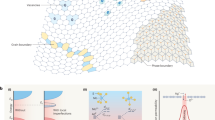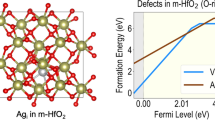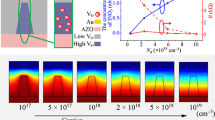Abstract
It is widely believed that switching to the conductive state in memristive materials is triggered by the external field that drives defect dynamics. In polycrystalline materials, grain boundaries are further believed to cause switching by enabling faster defect motion. Here, we report a firstprinciple study of oxygen vacancy dynamics at a grain boundary (GB) in polycrystalline ZnO and show that switching to the conductive state is triggered by a recombination-enhanced motion of vacancies perpendicular to the GB. We call this mechanism the “breathing” trigger of memristive switching.



Similar content being viewed by others
References
D.B. Strukov, G.S. Snider, D.R. Stewart, and R.S. Williams: The missing memristor found. Nature 453, 80 (2008).
L.O. Chua and S.M. Kang: Memristive devices and systems. Proc. IEEE 64, 209 (1976).
H. Akinaga and H. Shima: Resistive random access memory (ReRAM) based on metal oxides. IEEE 98, 2237 (2010).
B. Muthuswamy and P.P. Kokate: Memristor-based chaotic circuits. IETE Tech. Rev. 26, 417 (2009).
S.H. Jo, T. Chang, I. Ebong, B.B. Bhadviya, P. Mazumder, and W. Lu: Nanoscale memristor device as synapse in neuromorphic systems. Nano Lett. 10, 1297 (2010).
Y.V. Pershin and M. Di Ventra: Spin memristive systems: spin memory effects in semiconductor spintronics. Phys. Rev. B 78, 113309 (2008).
L.A. Agapito, S. Alkis, J.L. Krause, and H.-P. Cheng: Atomistic origins of molecular memristors. J. Phys. Chem. C 113, 20713 (2009).
A. Chanthbouala, V. Garcia, R.O. Cherifi, K. Bouzehouane, S. Fusil, X. Moya, S. Xavier, H. Yamada, C. Deranlot, N.D. Mathur, M. Bibes, A. Barthélémy, and J. Grollier: A ferroelectric memristor. Nat. Mater. 11, 860 (2012).
A.S. Oblea, A. Timilsina, D. Moore, and K.A. Campbell: Silver chalcogenide based memristor devices. In IEEE International Joint Conference on Neural Networks. Proceedings, 2010; p. 1.
A. Asamitsu, Y. Tomioka, H. Kuwahara, and Y. Tokura: Current switching of resistive states in magnetoresistive manganites. Nature 388, 50 (1997).
H.Y. Lee, P-S. Chen, T-Y. Wu, Y.S. Chen, F. Chen, C-C. Wang, P-J. Tzeng, C.H. Lin, M-J. Tsai, and C. Lien: HfOx bipolar resistive memory with robust endurance using AlCu as buffer electrode. IEEE Electron Device Lett. 30, 703 (2009).
I.G. Baek, M.S. Lee, S. Seo, M.J. Lee, D.H. Seo, D-S. Suh, J.C. Park, S.O. Park, H.S. Kim, I.K. Yoo, U-In Chungand I.T. Moon: Highly scalable nonvolatile resistive memory using simple binary oxide driven by asymmetric unipolar voltage pulses. In Electron Devices Meeting, 2004. IEDM Technical Digest. IEEE International, 2004; p. 587.
W-Y. Chang, Y-C. Lai, T-B. Wu, S-F. Wang, F. Chen, and M-J. Tsai: Unipolar resistive switching characteristics of ZnO thin films for nonvolatile memory applications. Appl. Phys. Lett. 92, 022110 (2008).
N. Xu, L. Liu, X. Sun, X. Liu, D. Han, Y. Wang, R. Han, J. Kang, and B. Yu: Characteristics and mechanism of conduction/set process in TiN/ZnO/Pt resistance switching random-access memories. Appl. Phys. Lett. 92, 232112 (2008).
S. Lee, H. Kim, D.-J. Yun, S.-W. Rhee, and K. Yong: Resistive switching characteristics of ZnO thin film grown on stainless steel for flexible nonvolatile memory devices. Appl. Phys. Lett. 95, 262113 (2009).
K. McKenna and A. Shluger: The interaction of oxygen vacancies with grain boundaries in monoclinic HfO2. Appl. Phys. Lett. 95, 222111 (2009).
K. Szot, W. Speier, G. Bihlmayer, and R. Waser: Switching the electrical resistance of individual dislocations in single-crystalline SrTiO3. Nat. Mater. 5, 312 (2006).
C. Park, S.H. Jeon, S.C. Chae, S. Han, B.H. Park, S. Seo, and D-W. Kim: Role of structural defects in the unipolar resistive switching characteristics of Pt/NiO/Pt structures. Appl. Phys. Lett. 93, 042102 (2008).
S. Yu and P.S. Wong: A phenomenological model of oxygen ion transport for metal oxide resistive switching memory. In Memory Workshop (IMW), 2010 IEEE International, 2010; p. 54.
W. Korner, P.D. Bristowe, and C. Elsasser: Density functional theory study of stoichiometric and nonstoichiometric ZnO grain boundaries. Phys. Rev. B 84, 045305 (2011).
J. Perdew, K. Burke, and M. Ernzerhof: Generalized gradient approximation made simple. Phys. Rev. Lett. 77, 3865 (1996).
G. Kresse and D. Joubert: From ultrasoft pseudopotentials to the projector augmented-wave method. Phys. Rev. B 59, 1758 (1999).
G. Kresse and J. Furthmuller: Efficient iterative schemes for ab initio total-energy calculations using a plane-wave basis set. Phys. Rev. B 54, 11169 (1996).
G. Henkelman and H. Jonsson: Improved tangent estimate in the nudged elastic band method for finding minimum energy paths and saddle points. J. Chem. Phys. 113, 9978 (2000).
A. Janotti and C.G. Van de Walle: Oxygen vacancies in ZnO. Appl. Phys. Lett. 87, 122102 (2005).
D.V. Lang: Recombination-enhanced reactions in semiconductors. Ann. Rev. of Mater. Sci. 12, 377 (1982).
N. Itoh and A.M. Stoneham: Materials Modification by Electronic Excitation (Cambridge University Press, Cambridge, UK, 2001).
S. Zh. Karazhanov, Y. Zhang, W.-L. Wang, A. Mascarenhas, and S. Deb: Resonant defect states and strong lattice relaxation of oxygen vacancies in WO3. Phys. Rev. B 68, 233204 (2003).
J.L. Gavartin, D. Muñoz Ramo, A.L. Shluger, G. Bersuker, and B.H. Lee: Negative oxygen vacancies in HfO2 as charge traps in high-k stacks. Appl. Phys. Lett. 89, 082908 (2006).
S. Kim, H. Moon, D. Gupta, S. Yoo, and Y.-K. Choi: Resistive switching characteristics of Sol–Gel zinc oxide films for flexible memory applications. IEEE Trans. Electron Devices 56, 696 (2009).
Acknowledgments
This work was supported by National Science Foundationgrant DMR-1207241 and the McMinn Endowment at Vanderbilt University. Computational support was provided by the NSF XSEDE under Grant # DMR130072.
Author information
Authors and Affiliations
Corresponding author
Rights and permissions
About this article
Cite this article
Shen, X., Puzyrev, Y.S. & Pantelides, S.T. Vacancy breathing by grain boundaries—a mechanism of memristive switching in polycrystalline oxides. MRS Communications 3, 167–170 (2013). https://doi.org/10.1557/mrc.2013.32
Received:
Accepted:
Published:
Issue Date:
DOI: https://doi.org/10.1557/mrc.2013.32




